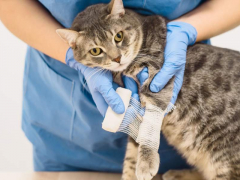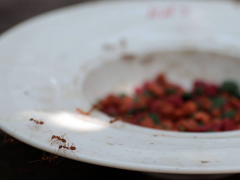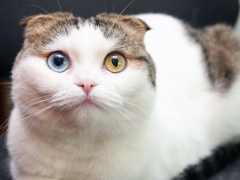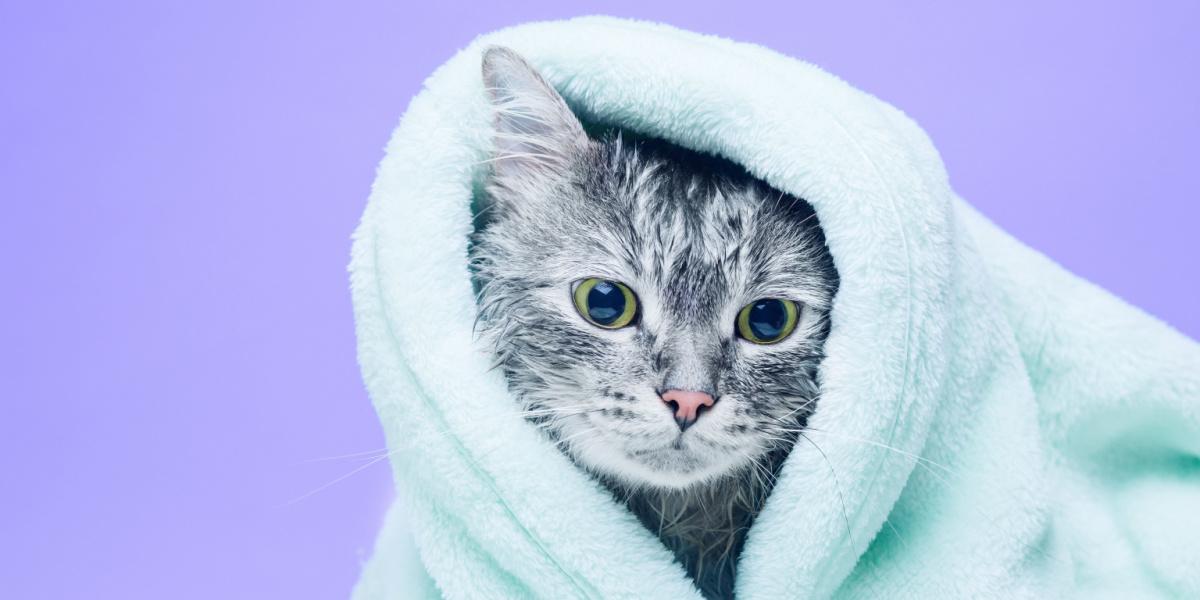
Cats are known for being fastidious groomers, and most spend many hours licking and washing themselves to keep their coats in clean condition. Consequently, most cats never require their owners to bathe them, which is lucky as most cats are not fans of the bathtub!
Owners of show cats, or longhaired cats prone to tangles and knots, might wash their pets on a more regular basis.
Occasionally, the naturally curious nature of cats will lead them into mischief, and they might return home with a dangerous or unpleasant substance on their fur that needs to be removed immediately.
Why Might A Cat Need To Be Washed?
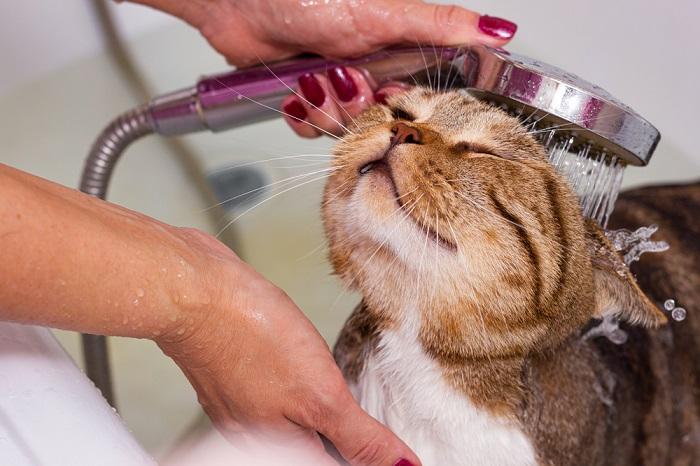
If your cat gets something dangerous or unpleasant on their coat, wash it off as quickly as possible.
Although it is unusual to need to wash cats, there are several reasons they might need a bath:
- They have an unpleasant substance on their coat such as motor oil, grease, or dirt. It is important to wash off certain substances before the cat tries to lick themselves clean, especially if they might be toxic. It is vital to get advice from your veterinarian if you think your cat might have something harmful on their fur.
- They are not grooming themselves properly because of health issues such as obesity, arthritis, or dental pain.
- They are going to a cat show and need to display a pristine coat.
- They have itchy skin due to allergies, skin infections, or parasites like fleas. Your veterinarian will be able to advise you on the best shampoo to help your pet’s specific condition.
For most of these scenarios, there is time to obtain a specific cat shampoo to ensure you are using a safe and effective product before washing your cat.
Also Read: The 6 Best Flea Shampoos For Cats
10 Simple Steps For Washing A Cat
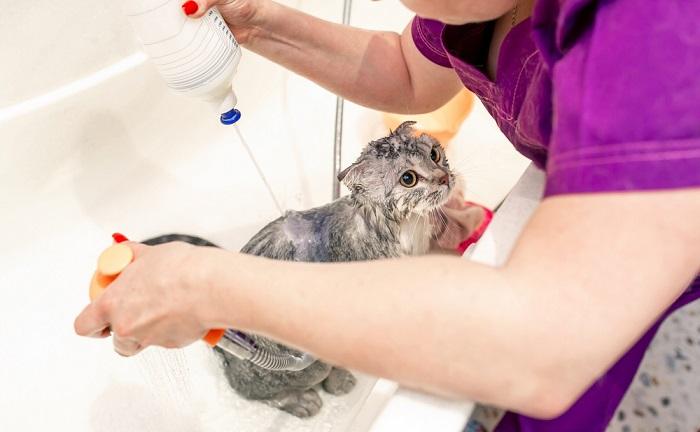
Wet your cat’s coat down to the skin before applying the shampoo or soap.
Once you have decided what you are going to use to wash your cat with, it’s time to get ready to bathe them. It is often helpful to have an extra pair of hands to wash a cat, so try to enlist some help from someone your cat knows well and is comfortable with.
- Preparation is key. If you cat has not been regularly bathed since kitten-hood they are likely to object (potentially quite strongly). Gather all of the items you need ready before you start. Wear long sleeves in case your cat tries to scratch you, and consider gloves and an apron (especially if you are bathing something unpleasant off your cat).
- Ready the room. Consider playing some calming classical music, and using a pheromone product to help reassure your cat.
- Prepare the tub. It’s easier to use a waist-high sink rather than leaning over a bathtub to wash a cat. Not only will it be kinder to your back and knees, but you will also have more control over your cat in a smaller area like a sink. Place a towel or rubber mat on the bottom of the sink to provide some grip for your cat and help them feel more secure. Fill the sink with three to four inches of warm water. Your cat will panic if you try to lower or dunk them into deeper water.
- Clip your cat’s nails to reduce your chances of getting scratched.
- Gently lower your cat into the sink. Use one hand to steady their neck and the other to gently encircle their body so they can’t jump out.
- Gradually wet their fur using a low-power shower head or cups of water, starting near the tail and working up to the neck area. Do not pour or spray water onto your cat’s face. If you use a shower head, keep the spray close to your cat’s body as they are less likely to object to this.
- Gently massage a small amount your chosen product (e.g., baby shampoo or dish soap) into the dirty area of fur and lather to remove the unwanted substance. Rinse well with clean water to remove all residue of the cleaning solution from your cat’s fur.
- Wipe around your cat’s face, eyes and ears with a damp cloth or cotton ball. Using a towel, gently remove as much water as possible from the coat while your cat is still in the sink, then wrap and gently dry them in a second towel.
- Dry the coat as much as possible, especially in colder weather. Some cats will tolerate a hair dryer on the lowest heat and speed settings. Make sure to brush through the coat well, especially for longhaired cats.
- Offer lots of praise and reward your cat with some of their favorite treats to try to create a positive association with being washed for the future.
For many cats, this might be the first time they have been washed, and they might not be very happy about it. Make the whole process as quick as possible to reduce your cat’s stress levels by being prepared and getting everything you need ready before beginning to wash your cat.
Also Read: The 7 Best Cat Wipes For Dander And Dirt
Other Safe Alternatives To Cat Shampoo
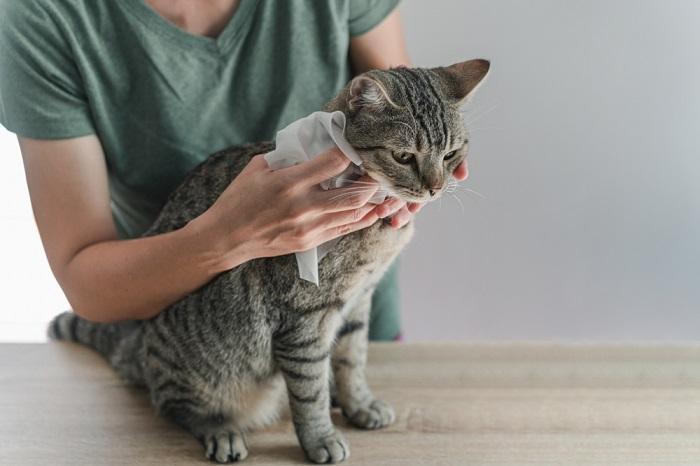
Plain water or a pet wipe can remove minor dust or dirt from the coat.
In a more urgent situation where a substance needs to be removed from your cat’s fur as quickly as possible, but you do not have cat shampoo in the house, there are some safe alternatives you could consider:
- Plain warm water: Depending on what you are trying to wash out of your cat’s fur this is a very safe method. A damp washcloth can be used for cats that refuse a full bath. However, plain water will not be effective against oily or sticky substances, and might not remove odors well.
- Pet wipes or baby wipes: These can be useful for removing localized patches from your cat’s fur. If you do not have pet wipes in the house, you can use baby wipes, but only if they are water-based. Never use sanitizing wipes on your pet.
- Baby shampoo: Human skin has a different pH than cat skin, so in general we advise not to use a shampoo designed for people on your pet as it can cause irritation and dryness. However, a small amount of unscented baby shampoo is fine to use as a one-off and has the benefit of also having a “no tears” formulation so it shouldn’t irritate your cat’s eyes if they get accidentally splashed.
- Dawn dish soap: Used by many wildlife rehabilitators to remove oil from fur and feathers, Dawn dish soap can also be used sparingly to remove oily substances from your pet’s fur. Avoid getting any soap near your cat’s face and sensitive eye area.
- Soap: Soaps are excellent at removing greasy or sticky materials from fur, but check the ingredients carefully before use. Avoid soaps containing essential oils, which can be toxic to cats.
Also Read: 10 Toxic & Poisonous Plants For Cats
Substances To Avoid Washing A Cat With
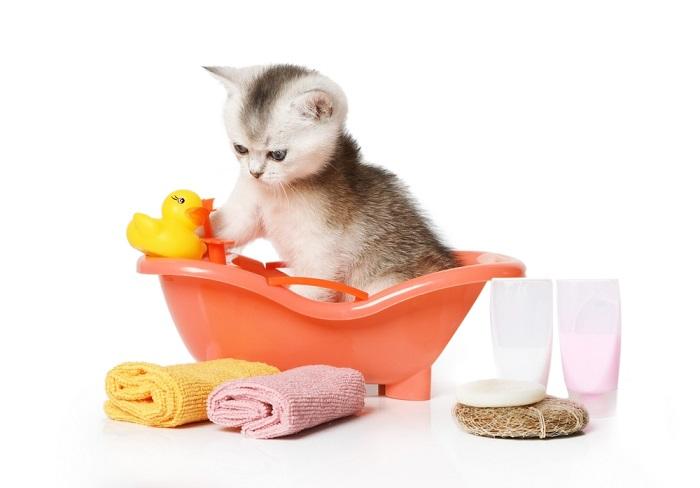
Dog shampoos that contain certain parasiticides or essential oils should not be used on cats.
Many people suggest using vinegar as an alternative to shampoo to wash cats, but this is not recommended by some dermatologists unless specific skin conditions are being treated. If you do use vinegar ensure it is well-diluted so that the strong smell does not upset your cat, and it doesn’t irritate their skin.
Take care before using dog shampoo on your cat. Some dog shampoos might contain ingredients such as insecticides or essential oils that are safe for dogs but toxic to cats, so read the label carefully.
Also Read: Common Skin Problems In Cats: Causes and Treatments
Final Thoughts
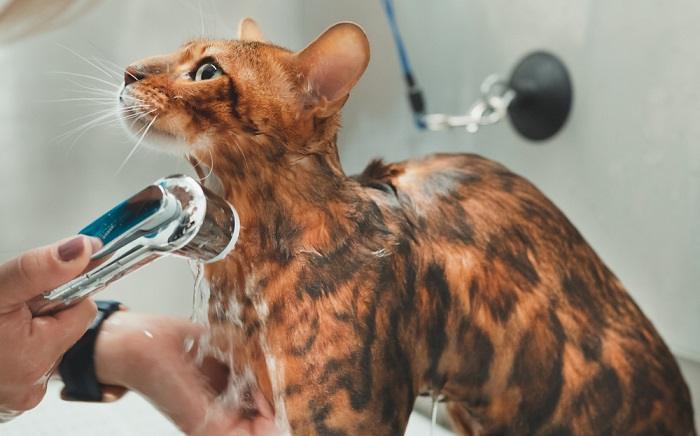
Even if you don’t plan to wash your cat regularly, it’s good to have some cat shampoo on hand for emergencies.
Unless you have an urgent need to wash your cat because they have managed to get an unpleasant or dangerous substance on their coat, you should purchase a specific cat shampoo before bathing your pet. Given their fastidious grooming habits, most cats never require a bath, so it is not uncommon for cat owners to be faced with a situation where they need to wash their pet without delay, but they do not have cat shampoo to hand.
Depending on the substance you are trying to remove, various products including baby shampoo and Dawn dish soap can be used as a one-off, or you can even use plain warm water. Follow our simple steps above to try and ensure that washing your cat goes as smoothly as possible, and don’t forget to give them lots of praise, affection, and treats to reward them afterward.
Also Read: Repetitive, Excessive And Compulsive Grooming In Cats
-
https://www.elsevier.com/books/muller-and-kirks-small-animal-dermatology/miller/978-1-4160-0028-0
